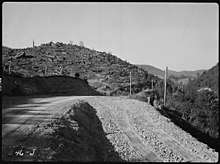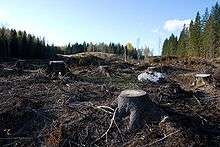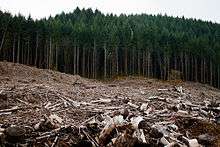Clearcutting
Clearcutting, clearfelling or clearcut logging is a forestry/logging practice in which most or all trees in an area are uniformly cut down. Along with shelterwood and seed tree harvests, it is used by foresters to create certain types of forest ecosystems and to promote select species[1] that require an abundance of sunlight or grow in large, even-age stands.[2] Logging companies and forest-worker unions in some countries support the practice for scientific, safety and economic reasons, while detractors consider it a form of deforestation that destroys natural habitats[3] and contributes to climate change.[4]
Clearcutting is the most common and economically profitable method of logging. However, it also creates detrimental side effects, such as the loss of topsoil, the costs of which are intensely debated by economic, environmental and other interests. In addition to the purpose of harvesting wood, clearcutting is used to create land for farming.[5] The "insatiable human demand for wood and arable land" through clearcutting and other activities has led to the loss of over half of the world's rainforests.[6]
While deforestation of both temperate and tropical rainforests through clearcutting has received considerable media attention in recent years, the other large forests of the world, such as the taiga, also known as boreal forests, are also under threat of rapid development. In Russia, North America and Scandinavia, creating protected areas and granting long-term leases to tend and regenerate trees—thus maximizing future harvests—are among the means used to limit the harmful effects of clearcutting.[7] Long-term studies of clearcut forests, such as studies of the Pasoh Rainforest in Malaysia, are also important in providing insights into the preservation of forest resources worldwide.[8]
Types
Many variations of clearcutting exist; the most common professional practices are:[9]
- Standard (uniform) clearcut – removal of every stem (whether commercially viable or not), so no canopy remains.
- Patch clearcut – removal of all the stems in a limited, predetermined area (patch).
- Strip clearcut – removal of all the stems in a row (strip), usually placed perpendicular to the prevailing winds in order to minimize the possibility of windthrow.[10]
- Clearcutting-with-reserves – removal of the majority of standing stems save a few reserved for other purposes (for example as snags for wildlife habitat), (often confused with the seed tree method).
- Slash-and-burn – the permanent conversion of tropical and subtropicals forests for agricultural purposes. This is most prevalent in tropical and subtropical forests in overpopulated regions in developing and least developed countries. Slash-and-burn entails the removal of all stems in a particular area. This can be a form of deforestation, when the land is converted to other uses. However, some indigenous forest peoples, for example the 19th century Forest Finns rotate over the land and it does return to forest and this would be sustainable. Slash and burn techniques are typically used by civilians in search of land for living and agricultural purposes. The forest is first clear cut, and the remaining material is burned. One of the driving forces behind this process is a result of overpopulation and subsequent sprawl. These methods also occur as a result of commercial farming. The lumber is sold for profit, and the land, cleared of all remaining brush and suitable for agricultural development, is sold to farmers.[5]
- Selection cutting – which can be done for timber harvesting or for ecological reasons. when so done it is often called ecoforestry.
Clearcutting contrasts with selective cutting, such as high grading, in which only commercially valuable trees are harvested, leaving all others. This practice can reduce the genetic viability of the forest over time, resulting in poorer or less vigorous offspring in the stand. Clearcutting also differs from a coppicing system, by allowing revegetation by seedlings. Additionally, destructive forms of forest management are commonly referred to as 'clearcutting'.
However it has been argued that in New Zealand clearcutting is more environmentally friendly as it uses less resources for logging and less land for wood production allowing other land to be kept as old growth forest .
Clearcutting regeneration, harvesting or system



Clearcutting can be differentiated into
- Clearcutting - clean felling by complete exploitation and removal of all the trees in one operation ... a harvesting method
- Clearcutting method - method for regenerating an even-aged community by removing all the mature trees
- Clearcutting system - a silvicultural system incorporating the clearcutting method to remove (clear) the mature community over a considerable area at one time[11]
Confusion between these different uses of the term is common. Furthermore, as indicated above many variations mean technically correct usage may not be descriptive enough to know what is meant on that particular occasion.
Effects on the environment
Environmental groups criticize clear-cutting as destructive to water, soil, wildlife, and atmosphere, and recommend the use of sustainable alternatives.[12] Clear-cutting has a very big impact on the water cycle. Trees hold water and topsoil. Clear-cutting in forests removes the trees which would otherwise have been transpiring large volumes of water and also physically damages the grasses, mosses, lichens, and ferns populating the understorey. All this bio-mass normally retains water during rainfall. Removal or damage of the biota reduces the local capacity to retain water, which can exacerbate flooding and lead to increased leaching of nutrients from the soil. The maximum nutrient loss occurs around year two, and returns to pre-clearcutting levels by year four.[13]
Clear-cutting also prevents trees from shading riverbanks, which raises the temperature of riverbanks and rivers, contributing to the extinction of some fish and amphibian species. Because the trees no longer hold down the soil, riverbanks increasingly erode as sediment into the water, creating excess nutrients which exacerbate the changes in the river and create problems miles away, in the sea.[12] All of the extra sediment and nutrients that leach into the streams cause the acidity of the stream to increase, which can kill marine life if the increase is great enough.[13] The nutrient content of the soil was found to return to five percent of pre-clearcutting levels after 64 years, which demonstrates how clearcutting affects the environment for many years.[14]
Clearcutting can destroy an area's ecological integrity in a number of ways, including: the destruction of buffer zones which reduce the severity of flooding by absorbing and holding water; the immediate removal of forest canopy, which destroys the habitat for many rainforest-dependent insects and bacteria; the removal of forest carbon sinks, leading to global warming through the increased human-induced and natural carbon dioxide build-up in the atmosphere; the elimination of fish and wildlife species due to soil erosion and habitat loss; the removal of underground worms, fungi and bacteria that condition soil and protect plants growing in it from disease; the loss of small-scale economic opportunities, such as fruit-picking, sap extraction, and rubber tapping; and the destruction of aesthetic values and recreational opportunities.[15]
Negative impacts
Clearcutting can have major negative impacts, both for humans and local flora and fauna.[16] A study from the University of Oregon found that in certain zones, areas that were clear cut had nearly three times the amount of erosion due to slides. When the roads required by the clearcutting were factored in, the increase in slide activity appeared to be about 5 times greater compared to nearby forested areas. The roads built for clearcutting interrupt normal surface drainage because the roads are not as permeable as the normal ground cover. The roads also change subsurface water movement due to the redistribution of soil and rock.[17] Clearcutting may lead to increased stream flow during storms, loss of habitat and species diversity, opportunities for invasive and weedy species, and negative impacts on scenery,[18] as well as a decrease in property values; diminished recreation, hunting, and fishing opportunities.[19] Clearcutting decreases the occurrence of natural disturbances like forest fires and natural uprooting. Over time, this can deplete the local seed bank.[20] An example of what clearcutting did in Ontario before 1900 can be found in Edmund Zavitz.
In temperate and boreal climates, clearcutting can have an effect on the depth of snow, which is usually greater in a clearcut area than in the forest, due to a lack of interception and evapotranspiration. This results in less soil frost, which in combination with higher levels of direct sunlight results in snowmelt occurring earlier in the spring and earlier peak runoff.[21]
The world's rain forests could completely vanish in a hundred years at the current rate of deforestation. Between June 2000 and June 2008 more than 150 000 square kilometers of rain forest were cleared in the Brazilian Amazon. Huge areas of forest have already been lost. For example, only eight to fourteen percent of the Atlantic Forest in South America now remains.[22][23] While deforestation rates have slowed since 2004, forest loss is expected to continue for the foreseeable future.[24] Farmers slash and burn large parcels of forest every year to create grazing and crop lands, but the forest's nutrient-poor soil often renders the land ill-suited for agriculture, and within a year or two, the farmers move on.[25]
Positive perspectives
Clearcutting can be practiced to encourage the growth and proliferation of tree species that require high light intensity.[26] Generally, a harvest area wider than double the height of the adjacent trees will no longer be subject to the moderating influence of the woodland on the microclimate.[2] The width of the harvest area can thus determine which species will come to dominate. Those with high tolerance to extremes in temperature, soil moisture, and resistance to browsing may be established, in particular secondary successional pioneer species.
Clearcutting can be used by foresters as a method of mimicking a natural disturbance and increasing primary successional species, such as poplar (aspen), willow and black cherry in North America. Clearcutting has also proved to be effective in creating animal habitat and browsing areas, which otherwise would not exist without natural stand-replacing disturbances such as wildfires, large scale windthrow, or avalanches.
Clearcuts are used to help regenerate species that cannot compete in mature forests. A number of them are aspen, jack pine and, in areas with poor soils, oaks—are important species for both game and nongame wildlife species. Clearcutting can also lead to increased vascular-plant diversity in the area. This is most pronounced after a couple years of clearcutting and in herb-rich forests where scarification took place.[20]
No significant changes in water temperature were observed when patch clearcutting was done 100 feet away from a river. This suggests that patch clearcutting is a possible solution to concerns about changes in water temperature due to clearcutting. The effects of clearcutting on soil nutrient content were not examined in this study.[27]
More recently, forest managers have found that clearcutting oak stands helps regenerate oak forests in areas of poor soil. The tree canopies in oak forests often shade out the ground, making it impossible for newly sprouted oaks to grow. When the mature trees are removed, the saplings stand a chance of recruiting into the forest.[28]
Effects on wildlife
Clearcutting's main destruction is towards habitats, where it makes the habitats more vulnerable in the future to damage by insects, diseases, acid rain, and wind. Removal of all trees from an area destroys the physical habitats of many species in wildlife. Also clearcutting can contribute to problems for ecosystems that depend on forests, like the streams and rivers which run through them.[29]
In Canada, the black-tailed deer population is at further risk after clearcutting. The deer are a food source for wolves and cougars, as well as First Nations and other hunters. While deer may not be at risk in cities and rural countryside, where they can be seen running through neighbourhoods and feeding on farms, in higher altitude areas they require forest shelter.[30]
See also
- Clearcutting in British Columbia
- Land clearing in Australia
- Even-aged timber management
- List of tree species by shade tolerance – shade intolerant and some intermediate species are primarily regenerated with clearcuts
- Seed production and gene diversity
- Deforestation
- Amazon rainforest
- Deforestation and climate change
References
- ↑ William Merivale (2013-08-14). "Budget for a €2,500/ha reforestation cost after clearfelling mature forest". FarmIreland.ie. Retrieved 2018-05-12.
- 1 2 Dr. J. Bowyer; K. Fernholz; A. Lindburg; Dr. J. Howe; Dr. S. Bratkovich (2009-05-28). "The Power of Silviculture: Employing Thinning, Partial Cutting Systems and Other Intermediate Treatments to Increase Productivity, Forest Health and Public Support for Forestry" (PDF). Dovetail Partners Inc. Archived from the original (pdf) on 2010-10-29. Retrieved 2009-06-06.
- ↑ U.S. Environmental Protection Agency, Washington, DC (1992). "Clear cut." Terms of Environment: Glossary, Abbreviations and Acronyms. p. 6. Document no. EPA-175-B-92-001. Accessed 2011-10-12.
- ↑ Center for Biological Diversity, Tucson, AZ. "Clearcutting and Climate Change." Accessed 2011-10-12.
- 1 2 Global Environmental Governance Project: Forests
- ↑ Rain Forest Threats. Retrieved: 2015-01-08.
- ↑ Kunganavolok (June 25, 1998). "Taiga! taiga! burning bright." The Economist. Retrieved: 2013-08-06.
- ↑ Khan, Madeline (February 9, 2004). "Clear cut forests in Malaysia offer lessons for logging worldwide." The Varsity, University of Toronto. Retrieved: 2013-08-06.
- ↑ Helms, John A. (1998-09-01). The Dictionary of Forestry. Society of American Foresters. ISBN 978-0-939970-73-5.
- ↑ British Columbia Ministry of Forests, Victoria, BC. "Clearcut System Variations." Introduction to Silvicultural Systems. Based on the published workbook: "Introduction to Silvicultural Systems, second edition (July 1999)." Forest Practices Branch.
- ↑ Nyland, Ralph D. (2007). Silviculture: concepts and applications,Ch 13 pg 277, 2nd ed. Prospect Heights: Waveland Press.
- 1 2 "Clear-cutting land Greeniacs Articles".
- 1 2 Martin, C. W., Pierce, R. S., Likens, G. E., & Bormann, F. H. (1986). Clearcutting affects stream chemistry in the White Mountains of New Hampshire. Broomall, PA: US Department of Agriculture, Forest Service, Northeastern Forest Experiment Station.
- ↑ Covington, W. W. (1981). Changes in forest floor organic matter and nutrient content following clear cutting in northern hardwoods. Ecology, 41-48.
- ↑ What Is Clearcutting? This method of logging can destroy an area's ecological integrity.
- ↑ Forest Encyclopedia Network Advantages and disadvantages of clearcutting
- ↑ Swanson, F.J.; Dyrness, C.T. (1975). "Impact of clear-cutting and road construction on soil erosion by landslides in the western Cascade Range, Oregon". Geology. Geological Society of America. 3 (7): 393–396. doi:10.1130/0091-7613(1975)3<393:IOCARC>2.0.CO;2.
- ↑ Toso Bozic (September 14, 2009). "Woodlot Harvest". Government of Alberta: Agriculture and Rural Development. Retrieved 2011-03-07.
- ↑ Foothill Conservancy, Pine Grove, CA (2001). "Clearcutting in local forests." Foothill Focus. Spring 2001. Accessed 2011-10-12.
- 1 2 Pykälä, J. (2004). Immediate increase in plant species richness after clear‐cutting of boreal herb‐rich forests. Applied vegetation science, 7(1), 29-34.
- ↑ Ottosson Löfvenius, M.; Kluge, M.; Lundmark, T.. (2003). "Snow and Soil Frost Depth in Two Types of Shelterwood and a Clear cut Area". Scandinavian Journal of Forest Research. Taylor & Francis. 18: 54–63. doi:10.1080/0891060310002345. ISSN 0282-7581.
- ↑ "Reforestation". Arkive. Retrieved 2013-01-10.
- ↑ "Brazil & the Atlantic Forest". The Nature Conservancy. Retrieved 2016-01-11.
- ↑ Future threats to the Amazon rainforest Archived 2012-11-01 at the Wayback Machine.
- ↑ National Geographic:rain forest threats
- ↑ Belt, Kevin and Campbell, Robert (1999). "The Clearcutting Controversy - Myths and Facts." West Virginia University Extension Service. Accessed 2011-12-12.
- ↑ Brown, G. W., & Krygier, J. T. (1970). Effects of clear‐cutting on stream temperature. Water resources research, 6(4), 1133–1139.
- ↑ "DNR - DNR". www.michigan.gov.
- ↑ Responses of Wildlife to Clearcutting and Associated Treatments in the Eastern United States. "Archived copy". Archived from the original on 2013-01-03. Retrieved 2012-11-08.
- ↑ "Ancient Forest Alliance - Old Growth Forests British Columbia". www.ancientforestguide.com.
- Roy, Vincent; Ruelb, Jean-Claude and Plamondon, André P. (1999). "Establishment, growth and survival of natural regeneration after clearcutting and drainage on forested wetlands." Forest Ecology and Management, Volume 129, Issues 1-3, 17 April 2000, pp. 253–267.
External links
| Wikimedia Commons has media related to Clearcutting. |
| Look up clear cut in Wiktionary, the free dictionary. |
- Canadian Broadcasting Corporation (CBC) Digital Archives - Clearcutting and Logging: The War of the Woods
- Congressional Research Service (CRS) Reports regarding Clearcutting, accessed 14 December 2009
- Forest Policy Research page: California citizens to stop Sierra Pacifics plan to clearcut one million acres of Sierra forest, accessed 14 December 2009
- Ancient Forest News - Clearcutting threatens black-tailed deer
- Nova Scotia Public Lands Coalition: Clearcutting
- "Free Grassy » The Boreal Forest". Archived from the original on 2010-04-05. Retrieved 2014-06-29.
.jpg)